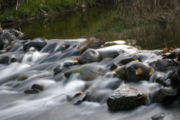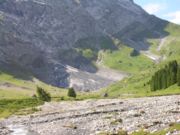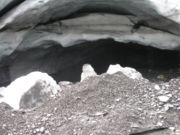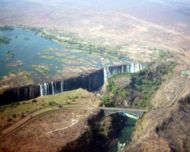River
2007 Schools Wikipedia Selection. Related subjects: Geology and geophysics
A river is a large natural waterway. The source of a river may be a lake, a spring, or a collection of small streams, known as headwaters. From their source, all rivers flow downhill, typically terminating in the ocean. The mouth, or lower end, of a river is known as its base level.
A river's water is confined to a channel, made up of a stream bed between banks. Most rainfall on land passes through a river on its way to the ocean. Smaller side streams that join a river are tributaries. The scientific term for any flowing natural waterway is a stream; so in technical language, the term river is just a shorthand way to refer to a large stream. Rivers throughout history have been the source and support for civilization, and many major cities today are near a river of some sort.
Topography
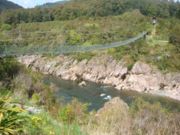
A river conducts water by constantly flowing perpendicular to the elevation curve of its bed, thereby converting the meander: start to form loops and snake through the plain by eroding the river banks. Sometimes the river will cut off a loop, shortening the channel and forming an oxbow lake from the cut off section. Rivers that carry large amounts of sediment develop conspicuous deltas at their mouths. Rivers whose mouths are in saline tidal waters may form estuaries.
Over time, rivers cut away at their beds especially in the steeper headwater regions, eventually forming a more gentle gradient. Although the following classes are a useful simplified way to visualize rivers, it is important to recognize there are other factors at work here. Gradient is controlled largely by tectonics, but discharge is controlled largely by climate and sediment load is controlled by various factors including climate, geology in the headwaters, and the stream gradient.
- Youthful river - a river with a steep gradient that has very few tributaries and flows quickly. Its channels erode deeper rather than wider.
- Mature river - a river with a gradient that is less steep than those of youthful rivers and flows more slowly than youthful rivers. A mature river is fed by many tributaries and has more discharge than a youthful river. Its channels erode wider rather than deeper.
- Old river - a river with a low gradient and low erosive energy. Old rivers are characterized by flood plains.
- Rejuvenated river - a river with a gradient that is raised by the earth's movement.
Where a river descends quickly over sloped topography, rapids with whitewater or even waterfalls occur. Rapids are often used for recreational purposes (see Whitewater kayaking). Waterfalls are sometimes used as sources of energy, via watermills and hydroelectric plants.
Rivers begin at their source in higher ground, either rising from a spring, forming from glacial meltwater, flowing from a body of water such as a lake, or simply from damp, boggy places where the soil is waterlogged. They end at their base level where they flow into a larger body of water, the sea, a lake, or as a tributary to another (usually larger) river. In arid areas rivers sometimes end by losing water to evaporation and percolation into dry, porous material such as sand, soil, or pervious rock. The area drained by a river and its tributaries is called its watershed, catchment basin or drainage basin. (Watershed is also used however to mean a boundary between drainage basins.)
Starting at the mouth of the river and following it upstream as it branches again and again, the resulting river network forms a dendritic (tree-like) structure that is an example of a natural random fractal.
Geopolitical boundaries
Rivers have been important historically in determining political boundaries. For example, the Danube was a longstanding border of the Roman Empire, and today forms most of the border between Bulgaria and Romania. The Mississippi in North America, and the Rhine in Europe, are major east-west boundaries in those continents. The Orange River forms the boundary between various provinces and countries along its route in Africa.
Rating systems
- International Scale of River Difficulty - The scale is used to rate the challenges of navigation—particularly those with rapids. Class I is the easiest and Class VI is the hardest.
- Strahler Stream Order - The Strahler Stream Order is a method to rank rivers based on the connectivity and hierarchy of contributing tributaries. Headwaters are first order while the Amazon River is twelfth order. Approximately 80 percent of the rivers and streams on Earth are of the first and second order.
Biology
The flora and fauna of rivers are much different from those of the ocean because the water is fresh (non-salty).
Flooding
Flooding is a natural part of a river's cycles. Human activity, however, has upset the natural way flooding occurs by walling off rivers and straightening their courses. Removal of bogs, swamps and other habitat. Today, many believe that the rebuilding of salmon runs is contingent upon reproducing the same environment shaped by logjams. In wintertime, rivers can be apart, it can lead to flash flooding downstream. Ice jams caused flooding in the Northeastern United States
Flow
A common misconception, particularly amongst schoolchildren and college students in North America, is that most, or even all, rivers flow from north to south. Rivers in fact flow downhill. Sometimes downhill is from north to south, but equally it can be from south to north, and usually is a complex meandering path involving all directions of the compass.
Studying the flows of rivers is one aspect of hydrology.
Management
In its natural state a river can be managed or controlled to make them more useful and less disruptive to human activity.
- Dams (see above) or weirs may be built to control the flow, store water, or extract energy.
- Levees may be built to prevent run-off of excess river water in times of flood.
- Canals connect rivers to one another for water transfer or navigation.
- River courses may be modified to improve navigation, or straightened to increase the flow rate.
River management is an ongoing activity as rivers tend to 'undo' the modifications made by man. Dredged channels silt up, sluice mechanisms deteriorate with age, levees and dams may suffer seepage or catastrophic failure.
River lists
The world's ten longest rivers
It is difficult to measure the length of a river, the more precise the measurement, the longer the river will seem. Also, it is difficult to determine where a river begins or ends, as very often, upstream rivers are formed by seasonal streams, swamps, or changing lakes.
These are average measurements.
- Nile (6,690 km)
- Amazon (6,452 km)
- Mississippi-Missouri (6,270 km)
- Yangtze (Chang Jiang) (6,245 km)
- Yenisey- Angara (5,550 km)
- Huang He (Yellow) (5,464 km)
- Ob- Irtysh (5,410 km)
- Amur (4,410 km)
- Congo (4,380 km)
- Lena (4,260 km)
For a longer list see Longest rivers. This also gives more information on measuring river lengths.
Well-known rivers (in alphabetic order)
- The Amazon River, the largest river in the world (in terms of volume and water cubic metres/second)
- The American River, the site of Sutter's Mill
- Amu Darya, the longest river in central Asia
- The Amur, the principal river of eastern Siberia and the border between Russia and China
- The Arkansas River, a major tributary of the Mississippi River
- The Arno, the river that runs through Florence
- The Arvandrud (Shatt al-Arab), the river that borders Iran and Iraq
- The Brahmaputra, the principal river in northeast India and Tibet
- The Chao Phraya, the principal river of Thailand
- The River Clyde, which runs through Glasgow
- The Colorado River (in Argentina)
- The Colorado River (in the United States), the principal river of the American Southwest
- The Columbia River, the principal river of the Pacific Northwest
- The Congo, the principal river of central Africa
- The Danube, the principal river of central and southeastern Europe
- Río de la Plata, the widest river in the world
- The Ebro, a river in northwestern Spain
- The Elbe, a major German river, running through the city of Hamburg
- The Euphrates, one of the twin principal rivers of Anatolia (Turkey) and Mesopotamia (Iraq)
- The Ganga, the principal river of India
- Han-gang, the river that runs through Seoul
- The Helmand River, the principal river of Afghanistan
- The Huang He (or Yellow River), one of the principal rivers of China
- The Hudson River, the principal river of New York
- The Indus River, the principal river of Pakistan
- The James River. the principal river of Virginia, historically important.
- The River Jordan, the principal river of Palestine, Jordan, and Israel
- Karun, the principal navigable river of southern Iran
- The River Kaveri, the principal river of South India
- The Lena, the principal river of northeastern Siberia
- The Mackenzie River, the longest river in Canada
- The Magdalena, the principal river of Colombia
- The Main, a river in Germany
- The Mekong, a principal river of Southeast Asia
- The River Mersey, the river on which sits the English city of Liverpool
- The Maas, the principal river of the southern provinces of the Netherlands and eastern Belgium
- The Mississippi River, the principal river of the central and southern United States
- The Missouri River, one of the principal rivers of the Great Plains
- The Murray River, the principal river of southeastern Australia
- The Niagara River, the river which flows between Lake Erie and Lake Ontario, and which flows over the Niagara Escarpment (better known as Niagara Falls)
- The Niger, the principal river of west Africa
- The Nile, the longest river in the world, principal to Egypt and northeastern Africa
- The Ob, a large river of Siberia
- The Oder, a major river in Central Europe
- The Ohio River, the largest river between the Mississippi and the Appalachian Mountains
- The Orinoco, the principal river of Venezuela
- The Rhine, one of the longest and most important rivers in Europe
- The Rio Grande, the river that forms part of the border between the United States and Mexico
- The Saint Lawrence River, which drains the Great Lakes
- The Sava, which flows through four countries—Slovenia, Croatia, Bosnia and Herzegovina (making its northern border) and Serbia—and was therefore one of the symbols of former Yugoslavia
- The Savannah River, a major river in the southeastern United States, forming most of the border between the states of Georgia and South Carolina
- The Seine, the river that runs through Paris
- The Segura, a river in southeastern Spain
- The River Severn, the longest river in Great Britain
- Shinano-gawa, the longest river in Japan
- The Snake River, the largest tributary of the Columbia River in Washington
- The Susquehanna River, the principal river of Pennsylvania and the Chesapeake Bay
- Tajo, the largest river in the Iberian Peninsula
- The River Tay, the largest river in Scotland
- The Tennessee River, an important tributary of the Mississippi that flows through Eastern/Western Tennessee, Northern Alabama, and Kentucky
- The Thames, the river that runs through London
- The Tiber, the river that runs through Rome
- The Tigris, one of the twin principal rivers of Anatolia (Turkey) and Mesopotamia (Iraq)
- Tonegawa, one of the largest rivers in Japan
- The Vistula, the principal river of Poland
- The Vltava, the river that runs through Prague
- The Volga River, the principal river of Russia
- The Wabash River, the principal river of Indiana
- The Yangtze (Chang Jiang), the longest river in China
- The Yenisei, a large river in Siberia
- The Yukon, the principal river of Alaska and the Yukon Territory
- The Zambezi, the principal river of southeastern Africa
Other lists
- List of waterways
- List of rivers of Oceania
- List of rivers of New Zealand
- List of rivers of Oceania
- List of river name etymologies
Rivers in myth and fiction
Real rivers
- the Thames in Edward Rutherfurd's London
- the Thames in Jerome K. Jerome's Three Men in a Boat
- the Thames and the Congo in Joseph Conrad's Heart of Darkness
- the Mississippi in Mark Twain's Huckleberry Finn
- the River Liffey through Dublin in James Joyce's Finnegans Wake
Mythological rivers
- in Greek mythology, the Acheron, Cocytus, Phlegethon, Lethe and Styx (the five rivers of Hades); and the Eridanus
- Virginia's Nancy River alleged to have had mystical healing powers
- the Alph, an underground river imagined by various mystics and mentioned in Coleridge's poem Kubla Khan
- Zora's River in Ocarina of Time
- the Tamanawis River in David James Duncan's "The River Why?"
- the Anduin in J.R.R Tolkien's The Lord Of The Rings

